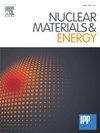Asymmetry in particle load on divertor tiles in different magnetic field configurations of LHD
IF 2.3
2区 物理与天体物理
Q1 NUCLEAR SCIENCE & TECHNOLOGY
引用次数: 0
Abstract
The asymmetry of plasma-particle load on divertor tiles at helically symmetrical positions has been investigated in the Large Helical Device (LHD). The asymmetry reverses when the toroidal magnetic field direction changes, suggesting that particle drifts cause the asymmetry. This study conducted proton orbit tracing calculations under a vacuum condition to investigate the effects of grad-B drift and curvature drift on the asymmetry. The calculations were performed for the major radius of the magnetic axis, Rax, at 3.75 m and 3.6 m configurations. The results showed that due to the effects of grad-B drift and curvature drift, a similar asymmetry to the experimentally observed one appeared in the number of protons reaching the divertor tiles. The degree of asymmetry (DOA), representing the ratio of protons reaching the symmetrical divertor tiles, increased with higher proton energy and was smaller for the Rax = 3.75 m configuration than the Rax = 3.6 m one. An analysis of the experimental data for these magnetic field configurations revealed a consistent asymmetry between the Rax = 3.75 m and the Rax = 3.6 m configuration. It was also found that the asymmetry increased with higher electron temperature and was smaller in the Rax = 3.75 m configuration than in the Rax = 3.6 m one, which was consistent with the calculations. On the other hand, the experiments showed that the DOA saturated, which was not reproduced in the calculations.
求助全文
约1分钟内获得全文
求助全文
来源期刊

Nuclear Materials and Energy
Materials Science-Materials Science (miscellaneous)
CiteScore
3.70
自引率
15.40%
发文量
175
审稿时长
20 weeks
期刊介绍:
The open-access journal Nuclear Materials and Energy is devoted to the growing field of research for material application in the production of nuclear energy. Nuclear Materials and Energy publishes original research articles of up to 6 pages in length.
 求助内容:
求助内容: 应助结果提醒方式:
应助结果提醒方式:


